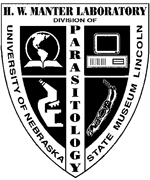Parasitology, Harold W. Manter Laboratory of

Harold W. Manter Laboratory: Library Materials
Document Type
Article
Date of this Version
9-1965
Citation
Illinois Biological Monographs 33 (1965)
Abstract
This monograph summarizes the known information on taxonomy, morphology, life cycle, hosts, location in the host, pathogenicity, geographic distribution, and cross-transmission studies of the 196 named species of coccidia of rodents. These include 176 species of Eimeria, 9 of Isospora, 3 of Wenyonella, 2 each of Cryptosporidium and Klossiella, and 1 each of Dorisiella, Caryospora, Tyzzeria, and Klossia. In addition, similar data are given for those forms for which insufficient information is available to justify assigning them names.
Eimeria, which is the most common genus, has been described from only 15% of the 337 genera and 4% of the 2,688 species of rodents. The location in the host is known for 45 species of Eimeria (26% of those named), the endogenous stages are known for 25 species (14% of those named), and complete life cycles have been worked out for only 4 species. Among the other coccidian genera, the location in the host, endogenous stages and life cycles are known only for Cryptosporidium, Klossiella, and 1 species of Wenyonella.
In general, the oocysts of rodent Eimeria usually lack a micropyle (82% of 176 species in which the presence or absence of this character has been mentioned), lack an oocyst residuum (65% of 171 species), may or may not have a polar granule (57% of 156 species have one) or a sporocyst Stieda body (60% of 126 species have one), and usually have a sporocyst residuum (89% of 166 species). Rodent Eimerias cannot be differentiated from the Eimerias of other hosts on the basis of the presence or absence of any of these characters. No evidence of parallel evolution between hosts and parasites was ob served among rodent Eimerias. The morphological characters of the parasite species have not changed progressively, but appear to have arisen more or less at random.
Cross-infection experiments have been carried out with 20 species of Eimeria from 16 donor hosts. Eight out of 9 attempts to transfer Eimeria between species of the same rodent genus were successful, but none of 47 attempts to transfer it to a species in a different rodent genus, even within the same family, succeeded.
The following new species of coccidia are described for the first time: Eimeria hansonorum n. sp. and E. ferrisi n. sp. from the wild house mouse (Mus musculus); and Isospora ratti n. sp. from the wild Norway rat (Rattus norvegicus).
The following are established as new species of Eimeria: E. moelleri n. sp. for the form described from Sciurus carolinensis by l\Ioller (1923) and assigned by him to E. sciurorum; E. ascotensis n. sp. for the form described from Sciurus carolinensis by Webster (1960) and assigned by him to E. neosciuri; E. kniplingi n. sp. for the form described from Sciurus niger rufiventer by Knipling and Becker (1935) and assigned by them to E. sciurorum)· E. asiatici n. sp. for the form described from Eutamias asiaticus by Tanabe and Okinami (1940) and assigned by them to E. beecheyi; E. batabatensis n. sp. for the form described from Arvicola terrestris by Musaev and Ve'Isov (1960) and assigned by them to E. arvicolae; E. rysavyi n. sp. for the form described by Rysavy (1957) from Clethriononiys glareolus and assigned by him to E. apodemi; E. kazakhstanensis n. sp. for the form described from Ellobius talpinus by Svanbaev (1956) and assigned by him to E. volgensis; E. talpini n. sp. for the form described from Ellobius talpinus by Svanbaev (1956) and assigned by him to E. beckeri)· E. tamariscini n. sp. for the form described from Meriones tamariscinus by Svanbaev (1956) and assigned by him to E. musculi; E. hungaryensis n. sp. for the form described from Apodemus flavicollis by Pellérdy (1954) and assigned by him to E. muris; E. prasadi n. sp. for the form described from Apodemus sylvaticus by Svanbaev (1956) and assigned by him to E. hindlei; E. svanbaevi n. sp. for the form described from Apodemus sylvaticus by Svanbaev (1956) and assigned by him to E. krijgsmanni; E. russiensis n. sp. for the form described from Apodemus sylvaticus by Svanbaev (1956) and assigned by him to E. musculi; E. heterocephali n. sp. for the form described from Heterocephalus glaber by Porter (1957) and assigned by her to E. muris; E. cernae n. sp. for the form described from Clethrionomys glareolusby Černa (1962) and assigned by her to E. schueffneri; E. susliki n. sp. for the form described from Spermophilus maximus by Svanbaev (1962) and assigned by him to E. ussuriensis: E. peschankae n. sp. for the form described from Meriones tamariscinus by Svanbaev (1962) and assigned by him to E. krijgsmanni; E. assaensis n. sp. for the form described from Meriones tamariscinus by Svanbaev (1962) and assigned by him to E. callospennophili; and E. dorneyi n. sp. for the form described from Glaucomys sabrinus macrotis by Dorney (1962) and called Eimeria sp. by him.
The following species of Eimeria are redescribed: E. nieschulzi from Rattus norvegicus in Illinois and from R. hawaiiensis in Hawaii (new host record); E. separata from Rattus norvegicus in Illinois and from R. hawaiiensis in Hawaii (new host record); and E. falciformis from Mus musculus in Illinois.


Comments
Used by permission
Digitized by the Internet Archive